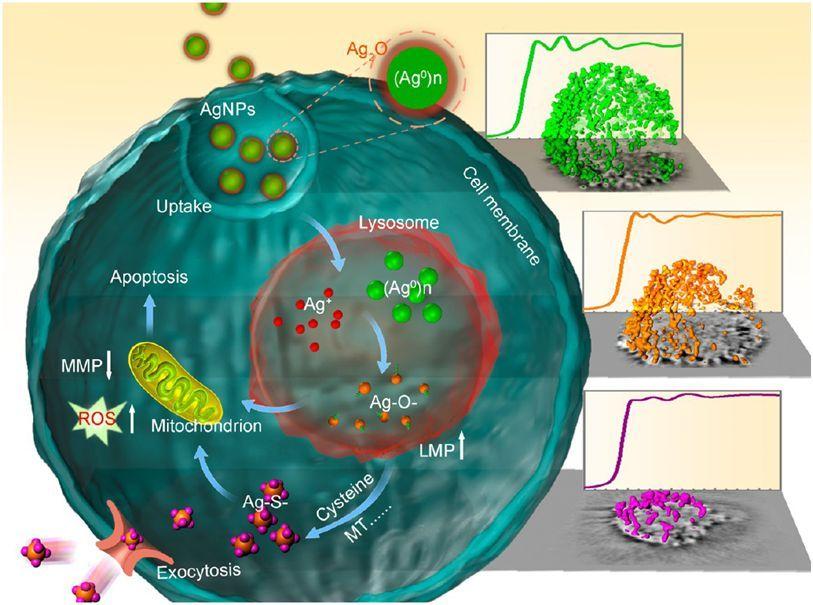Compared to the bulk silver, silver nanoparticles (AgNPs) have a smaller size and larger surface area that enable them ability of quick degradation into ions and strong reactivity, and excellent antibacterial property. AgNPs have been thus widely used in antimicrobial products such as medical dressing, articles for babies, and coatings for food packing, refrigerator, and clothing. However, AgNPs are prone to release silver ion in environment and body fluids, which probably causes risks to environment and health. Nowadays, public and the government have paid close attentions to the safety of AgNPs and the dosage range for safe usage. To understand AgNP safety, it is crucial to the correlate biological effects of AgNPs with their potential chemical mechanism such as the chemical transformation during intracellular processes of NPs. However, it is a grand challenge to capture a high-resolution image of metallic NPs in a single cell and the chemical information on intracellular NPs.
Recently, Prof. Chunying Chen’s group has successfully revealed the chemical origin of AgNP cytotoxicity by integrating synchrotron radiation (SR) beam transmission X-ray microscopy (SR-TXM) and SR-X-ray absorption near edge structure (SR-XANES) spectroscopy. In this study, SR-TXM can in situ capture the intracellular 3D accumulation and exocytosis of AgNPs inside a single human monocyte (THP-1), while SR-XANES is capable of revealing the chemical transformation of silver inside cells. The result shows that the cytotoxicity of AgNPs is largely due to the chemical transformation of particulate silver from elemental silver (Ag0)n, to Ag+ ions and Ag-O-, then Ag-S- species. As a result, Ag-S- speciation triggers mitochondrion-involved apoptosis and induces reactive oxygen species to cause cytotoxicity. The study indicates that particulate form of AgNPs, their degraded forms, and the induced ROS play synergetic roles in mediating AgNP cytotoxicity to human monocytes. The present study shows us with an advanced approach for nondestructive detection of intracellular metallic and metal oxide NPs, which provides direct information to reveal the chemical mechanisms of nanotoxicity for nanosafety assessment and application fields. More details about this work can be found in ACS Nano 2015, 9, 6532-6547. The first author Dr. Liming Wang is from Key Laboratory for Biomedical Effects of Nanomaterials and Nanosafety of Chinese Academy of Sciences.
This team has also shown that AgNP toxicity is largely influenced by the cellular uptake pathway, degraded forms of AgNPs, cell types, and the surface modifications. They found that AgNPs and ionic silver at the same dose can induce DNA damage and chromosome aberration at different degrees (Toxicology Letters 2013, 222: 55-63; Nanotoxicology 2015, 9(2): 181-189). They also showed that cell types highly influence the uptake of AgNPs, the stress pathways, and the cellular sensitivity to AgNPs (Biomaterials. 2015, 61, 307-315). In addition, surface coatings play crucial roles in tuning biological effects of AgNPs such as the biological distribution and accumulation in vivo and the cytotoxicity in vitro (Nanotoxicology 2015, DOI: 10.3109/17435390.2015.1024295). These studies help us understand biomedical effects of AgNPs and will guide the design and synthesis of AgNPs for safe applications.
It was financially supported by the National Basic Research Program of China, the National Natural Science Foundation of China, the Chinese Academy of Sciences, Beijing Synchrotron Radiation Facility, and Shanghai Synchrotron Radiation Facility.

Figure. A schematic diagram of chemical mechanism of AgNP cytotoxicity revealed by SR-XANES, SR-TXM, and other techniques.
However, it is a grand challenge to capture a high-resolution image of metallic NPs in a single cell and the chemical information on intracellular NPs.
Recently, Prof. Chunying Chen’s group has successfully revealed the chemical origin of AgNP cytotoxicity by integrating synchrotron radiation (SR) beam transmission X-ray microscopy (SR-TXM) and SR-X-ray absorption near edge structure (SR-XANES) spectroscopy. In this study, SR-TXM can in situ capture the intracellular 3D accumulation and exocytosis of AgNPs inside a single human monocyte (THP-1), while SR-XANES is capable of revealing the chemical transformation of silver inside cells. The result shows that the cytotoxicity of AgNPs is largely due to the chemical transformation of particulate silver from elemental silver (Ag0)n, to Ag+ ions and Ag-O-, then Ag-S- species. As a result, Ag-S- speciation triggers mitochondrion-involved apoptosis and induces reactive oxygen species to cause cytotoxicity. The study indicates that particulate form of AgNPs, their degraded forms, and the induced ROS play synergetic roles in mediating AgNP cytotoxicity to human monocytes. The present study shows us with an advanced approach for nondestructive detection of intracellular metallic and metal oxide NPs, which provides direct information to reveal the chemical mechanisms of nanotoxicity for nanosafety assessment and application fields. More details about this work can be found in ACS Nano 2015, 9, 6532-6547. The first author Dr. Liming Wang is from Key Laboratory for Biomedical Effects of Nanomaterials and Nanosafety of Chinese Academy of Sciences.
This team has also shown that AgNP toxicity is largely influenced by the cellular uptake pathway, degraded forms of AgNPs, cell types, and the surface modifications. They found that AgNPs and ionic silver at the same dose can induce DNA damage and chromosome aberration at different degrees (Toxicology Letters 2013, 222: 55-63; Nanotoxicology 2015, 9(2): 181-189). They also showed that cell types highly influence the uptake of AgNPs, the stress pathways, and the cellular sensitivity to AgNPs (Biomaterials. 2015, 61, 307-315). In addition, surface coatings play crucial roles in tuning biological effects of AgNPs such as the biological distribution and accumulation in vivo and the cytotoxicity in vitro (Nanotoxicology 2015, DOI: 10.3109/17435390.2015.1024295). These studies help us understand biomedical effects of AgNPs and will guide the design and synthesis of AgNPs for safe applications.
It was financially supported by the National Basic Research Program of China, the National Natural Science Foundation of China, the Chinese Academy of Sciences, Beijing Synchrotron Radiation Facility, and Shanghai Synchrotron Radiation Facility.

Figure. A schematic diagram of chemical mechanism of AgNP cytotoxicity revealed by SR-XANES, SR-TXM, and other techniques.
 Close Page
Close Page- Text Size: A A A
 Printer Friendly
Printer Friendly
